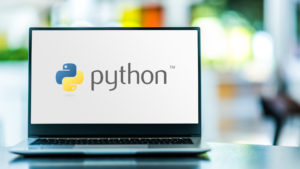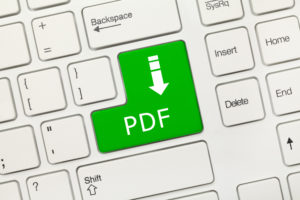
POZNAN, POL - FEB 6, 2021: Laptop computer displaying logo of Python interpreted, high-level and general-purpose programming language
Accessibility in a PDF context goes beyond the ability to open a file. It delves deeper into ensuring that the content within, whether text, images, or graphical data, is entirely accessible by all users, regardless of any disabilities they might have. This concept, in essence, advocates for the democratization of information, facilitating equal access and understanding for everyone.
In this quest for universal accessibility, many document converters such as https://www.foxit.com/word-to-pdf/ and many others are used to convert documents into more accessible formats. And as the need for accessibility grows, Python emerges as a powerful solution. Renowned for its versatility and ease of use, Python provides an array of robust libraries designed for PDF manipulation.
This article will discuss the six steps to enhance accessibility using Python:
- Installation Of Necessary Python Libraries

Close-up view on white conceptual keyboard - PDF (green key)
Enhancing PDF accessibility using Python starts with arming yourself with the necessary libraries. PyPDF2, PDFMiner, and pdfrw are essential components in this mission, akin to a mechanic's toolkit. These libraries provide the methods and functionalities that allow for comprehensive interaction with PDF files.
Installation of these libraries is the first step, simplified by Python's built-in pip installer. Executing the commands 'pip install PyPDF2', 'pip install PDFMiner,' and 'pip install pdfrw' in the command line triggers the installation process.
Post-installation, the actual work can commence. Now equipped with the necessary tools, the task of enhancing PDF accessibility awaits, much like a canvas awaits the first brushstroke of an artist.
- Extracting Text From PDFs
The next step is akin to mining for precious metals - extracting text from PDF files. Here, PDFMiner comes into the limelight. This library provides a method that converts the PDF document into a layout object, enabling easy access to the exact placement of each character in the document.
However, it can be a challenging ride. Complex layouts or unconventional font encodings could lead to errors during extraction, like hitting a tough rock vein during mining. Anticipating these challenges and having strategies to bypass them is crucial.
Despite these potential hitches, Python's capabilities still need to be improved. Using alternate methods provided by the libraries or creating workarounds enables you to extract the required text. Like solving a puzzle, each challenge requires a unique approach to reach the solution.
- Analyzing PDF Structure
Analyzing the structure of a PDF is the next step in the process. Understanding the PDF's structure, much like an architect studying a blueprint, provides insight into the organization of the data. With Python libraries, specifically PDFMiner, this understanding is achievable. The library allows access to the PDF's layout object, providing a detailed view of the structure.
However, challenges arise when faced with complex or non-standard structures. These situations demand additional strategizing, like a navigator altering course in response to unexpected obstacles.
Post analysis, with the structure understood and the way forward precise, manipulation of the PDF content becomes significantly easier. Just as a clear roadmap aids a smooth journey, understanding the structure smoothens the process of enhancing PDF accessibility.
- Adding Alt-Text To Images And Graphics
While rich in information, images and graphics within PDFs pose an accessibility challenge for visually impaired users. Alt-text becomes a necessity, acting as an auditory substitute for visual content. Python libraries like pdfrw come in handy at this stage. Pdfrw allows extraction of image data, to which alt-text can be added, much like adding subtitles to a film.
Adding alt-text, however, is more than just providing a description. It ensures the text is meaningful and contextually accurate, requiring a detailed understanding of the image or graphic's content.
Ensuring that the alt-text is effective and correctly conveys the image or graphic's information is critical in enhancing PDF accessibility. It's akin to crafting a good summary - it should encapsulate the essence without losing critical information.
- Adding Metadata And Semantic Structure
Metadata and semantic structure can be seen as the 'behind-the-scenes' elements of a PDF that play a crucial role in enhancing accessibility. Adding metadata involves providing information about the document and its content, a process facilitated by PyPDF2, which allows metadata editing in PDFs.
Creating a semantic structure involves defining relationships between elements within the PDF. This process is like creating a table of contents or an index - it helps users easily navigate the document.
As with any behind-the-scenes work, accuracy, and adherence to standard protocols are essential. With these elements correctly implemented, the scaffolding of the PDF is set up, ready to support the accessibility enhancements.
- Testing PDF Accessibility
The final stage involves testing the accessibility of the PDF. This is the evaluation stage to ensure that all enhancements work as intended. Python libraries like PyPDF2 and PDFMiner provide methods to review the changes made to the PDF.
However, testing is not a one-time process. It involves an iterative cycle of evaluating results, identifying issues, and implementing modifications. Much like proofreading a document, it's about finding and correcting errors to produce an excellent final product.
Conclusion
Enhancing PDF accessibility with Python is a meticulously detailed process involving multiple stages. However, with Python and its powerful libraries at your disposal, the path toward creating accessible PDFs is clear and manageable. Python's role in driving PDF accessibility continues to grow, inching closer to the goal of universal accessibility.
